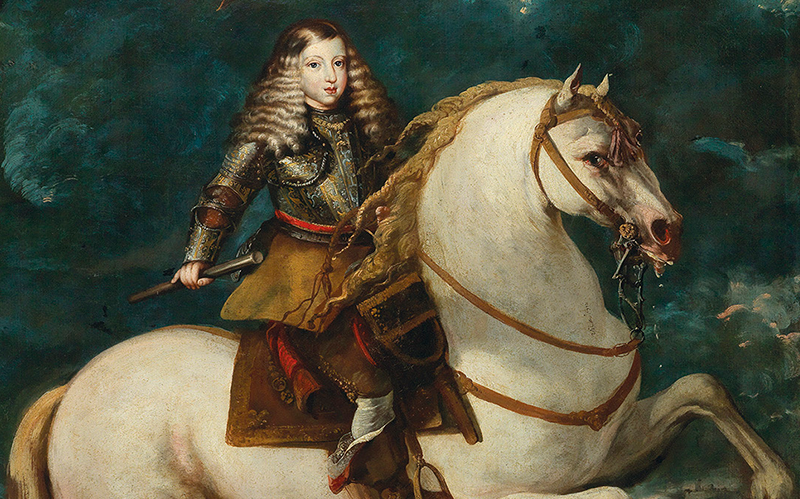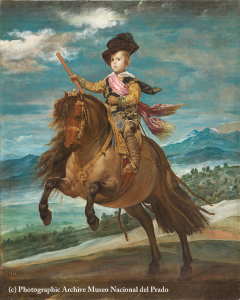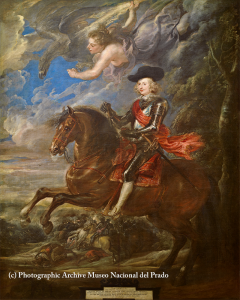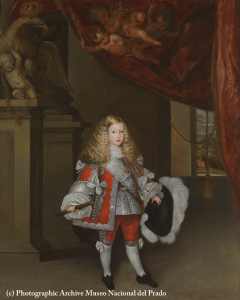
Portraits have always been powerful tools of dynastic propaganda, especially when depicting royalty, as is demonstrated in this impressive, recently rediscovered portrait.
Positive image
According to extensive research carried out by Spanish art historians Cipriano García-Hidalgo Villena and Gloria Martínez Leiva this painting was used by Spanish court painters as a model for variations of the composition. The royal workshop was an institution founded at the Royal Alcázar in Madrid to spread images of the Habsburg rulers by producing works after established portrait types. The present painting, executed by the court painter Sebastián Herrera Barnuevo, also served as a model to spread a positive image of the young king.
A symbol of presence
An impressive, almost flamboyant and victorious likeness of the king was used as a diplomatic gift and symbol of the presence of the ruler even in faraway regions of the empire. For Charles II, an image as powerful as this one was vital in conveying a picture of
an able and adept monarch who would ensure the continuation of Habsburg rule in the Spanish Empire. However, the reality would prove to be somewhat different.
The last Habsburg king
The ascension to the Spanish throne of the young boy shown here in September 1665 heralded one of the great tragedies of the Habsburg family which ultimately resulted in one of the bloodiest conflicts in European history – the War of the Spanish Succession. Charles was to be the last Habsburg king of Spain.
Court painter
Sebastián Herrera Barnuevo (1611–1671) was appointed court painter in 1667. Given the task of creating a royal portrait that would be powerful enough to quieten widespread rumours, he drew inspiration from two successful royal portrait types which had been
employed by earlier court painters.

On horse back
The first is the equestrian portrait of Balthasar Charles created by Velázquez for the Salón de Reinos of the Buen Retiro Palace. Examples of the first type, based on the Velázquez model and an apparently lost prototype by Barnuevo, can be found in many Spanish collections. They include a portrait attributed to Sebastian Herrera Barnuevo, Charles II on horseback, which is held by the Patrimonio Nacional in Madrid. Copies by the royal workshop vary strongly in quality. When Charles II was ten years old, approaching his legal age of 14, it was apparently decided to evolve the type of equestrian portraits that was supposed to endorse the image of the king. Barnuevo took his cue from Rubens’ famous equestrian portrait of Cardinal Infante Ferdinand.

Gold and Silver
The present painting depicts a landscape with almost nocturnal lighting under blue and leaden skies. The Infante appears on a white horse in a corvette posture. Wearing brown leather riding trousers, he has long, wavy blonde hair; his slight body is covered with a rich armour including decorations in gold and silver. The armour may be one of the Milanese pieces that Philip III wore during his childhood; in any case it appears to be similar to one in the Royal Armoury in Madrid. Charles wears the Order of the Golden Fleece around his neck and holds the commander’s baton in his right hand. In the upper left corner of the painting, an eagle carries a laurel wreath in its beak which crowns the child. Meanwhile, a battle is fought in the background of the lower part of the painting. This battle might represent the War of Devolution, that took place in 1668 and yielded one of the few Spanish victories during the reign of Charles II. The pose of the king is identical to a portrait from the Gil Nebot collection in the Prado, Madrid. The way in which the wavy hair and the face of the king are executed are similar in both paintings.

The present work is one of the most successful paintings by Sebastián Herrera Barnuevo, for it displays the painterly skill that ensured the artist’s succession to Juan Baustista Martínez del Mazo and Diego Rodríguez de Silva y Velázquez. It is one of his few known fully executed works.
We are grateful to Cipriano García-Hidalgo Villena and Gloria Martínez Leiva for their contribution to this article.
Information:
Mark MacDonnell, specialist for Old Master paintings













